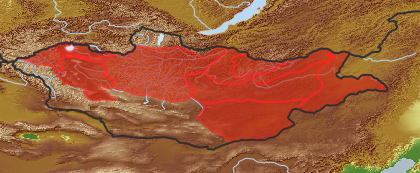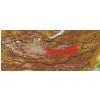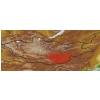| Class: | angiosperms |
| Order: | Rosales |
| Family: | Cannabaceae |
| Genus: | Cannabis |
| Scientific name: | Cannabis sativa L. |
| Name acc. to: | Gubanov 1996 |
| Herbar: | list records   |
| Synonym: | C. ruderalis Janisch. (acc. to Gubanov 1996) |
| Description: | Erect dioecious annual up to 3 m high. Leaves palmate, digitately compound with long petioles and toothed margins. Inflorescence developed as cymes in the axils of leaves. Flowers small, greenish, unisexual. Nutlets 4-5 mm long, light grey, glabrous and smooth. |
| Confuse with: | Grubov (1982) differentiated C. ruderalis by nutlets 3-3.8(4) mm long, dark grey or brown, with marble-like painting and often remnants of perianth in form of brown scarious scraps. |
| Tax. Comments: | The taxonomic value of the described names has been a subject of debate for over two centuries. Grubov (1982) has differentiated only two species by fruit features. We have not seen any fruiting material from the region. Therefore we are following Gubanov (1996), who recommitted C. ruderalis Jannisch to synonymy. |
| Comments: | Widely cultivated species: used for its fiber, to make paper and rope (hemp) and as drug (smoked or as intoxicating liquid).
Cannabis includes 3 putative species and numerous variants in Central Asia and surrounding regions. |
| Link to Flora of China: | http://www.efloras.org/browse.aspx?flora_id=2&name_str=Cannabis+sativa |
| open map in a new window |  |
| Habitat: | Cultivated plant, but readily escapes together with other cultivated field crops and occurs in fields, along irrigation ditches and roads (Grubov 2001) |
| Habit (i)general appearance of a plant | |
| Growth form: (i)Herb, shrub, tree or climber. | annual (i)Completing its life cycle within one year or one growing season; roots weak and thin  inherited by genus Cannabis: annual inherited by genus Cannabis: annual
herb (i)Herbaceous, erect plant, up to 2m high, mostly with a leafy shoot; if perennial, shoots die to the ground each season, shoots are not woody
example: Artemisia pectinata   inherited by genus Cannabis: herb inherited by genus Cannabis: herb
|
| Size of plant: (i)Attention: use flowering or fruiting specimens to assess plant height (many biennial plants possess only a basal rosette in the first year). | from 250 mm to 600 mm  inherited by genus Cannabis: inherited by genus Cannabis:
from 600 mm to 1000 mm  inherited by genus Cannabis: inherited by genus Cannabis:
from 1000 mm to 3000 mm  inherited by genus Cannabis: inherited by genus Cannabis:
|
| Parasite status: (i)Is the plant a half- or full parasite? | no parasite/saprophyte (i)Plant fully autonomous, leaves with chlorophyll
example: Most plants, Ranunculus  inherited by family Cannabaceae: no parasite/saprophyte inherited by family Cannabaceae: no parasite/saprophyte
|
| Water or terrestrial plant: (i)Where do the plants grow? | terrestrial (i)Plant grows on dry land
example: Orostachys spinosa  inherited by genus Cannabis: terrestrial inherited by genus Cannabis: terrestrial
|
| Leaf (i)expanded, usually photosynthetic organ of a plant (including phylloclades) | |
| Leaf development: (i)Structure and development of leaves. | with green leaves (i)Plant with green leaves  inherited by genus Cannabis: with green leaves inherited by genus Cannabis: with green leaves
|
| Leaf arrangement: (i)Arrangement of leaves at the stem. | opposite, opposite-decussate (i)Two leaves per node
example: Lamiaceae, e.g. Phlomis  
alternate (i)One leaf per node; distiche: arranged in two vertical rows, equitant
example: Phragmites    inherited by genus Cannabis: alternate inherited by genus Cannabis: alternate
|
| Simple or divided leaves: (i)Are the leaves simple or completely divided in several parts? Blade of the leaf entire or (more or less) deeply dissected. Attention: There are various appearances of the leaf margin (from entire to toothed and lobed). Here, we ignore this and ask only for dissections that separate the leaf for more than one third of its length or width, whatever is smaller. Sometimes, it is difficult to tell apart compound leaves from a shoot system with simple leaves: look for stipulae and/or axillary buds at the ground of the leaves: if only some possess these structures, the others are most likely leaflets of a compound leaf. | compound (i)Composed of several similar parts  inherited by genus Cannabis: compound inherited by genus Cannabis: compound
palmate (transition to palmatisected!) (i)Divided from a point, like the fingers of a hand
example: Cannabis, Hibiscus (3-5 parts)   inherited by genus Cannabis: palmate (transition to palmatisected!) inherited by genus Cannabis: palmate (transition to palmatisected!)
|
| Length of leaves: (i)How long is the leaf, be carefull in compound leaves, measure the complete leaf. | from 21 mm to 50 mm  inherited by genus Cannabis: inherited by genus Cannabis:
|
| Leaf apex: (i)Appearance of the tip of leaf resp. leaflets in compound leaves. | acuminate (i)Gradually tapering to a (sharp) point
example: Populus laurifolia?   inherited by genus Cannabis: acuminate inherited by genus Cannabis: acuminate
|
| Leaf margin: (i)Structure of leaf margin (or that of a leaflet in case of compound leaves). Attention: Here we ask for the leaf margin, defined as all those dissections that separate the leaf for less than one third of its length or width, whatever is smaller. To be worked out: how to handle margin of pinnate leaves? | serrate / dentate / crenulate (i)Margin saw-like or rounded teethed
example: Betula, Lophanthus (crenulate)   inherited by genus Cannabis: serrate / dentate / crenulate inherited by genus Cannabis: serrate / dentate / crenulate
|
| Leaf base: (i)The angle the leaf blade forms with a real or imaginary (sessile leaves) petiole. Attention: Here, we consider only the base of leaves or leaflets (in case of compound leaves). | cuneate (i)Tapering gradually, angle > 90° - 120°
example: Thalictrum, Betula fruticosa   inherited by genus Cannabis: cuneate inherited by genus Cannabis: cuneate
|
| Petiole: (i)Leaf divided into stalk (petiole) and blade. | with (i)Leaves with petiole (stalk)   inherited by genus Cannabis: with inherited by genus Cannabis: with
shorter than blade (i)Petiol shorter than leaf blade  inherited by genus Cannabis: shorter than blade inherited by genus Cannabis: shorter than blade
|
| Stipule: (i)Leaflets at the base of the petiole, these are smaller and of different shape. | none (i)Without stipules
example: Euphorbia, Ericaceae s.l.  inherited by genus Cannabis: none inherited by genus Cannabis: none
|
| Leaf colour upper side: (i)Shades of green on the leaf, upper side. | green (i)Clear green
example: Tribulus terrestris  inherited by genus Cannabis: green inherited by genus Cannabis: green
|
| Leaf colour lower side: (i)Shades of green on the leaf, lower side. | green (i)Clear green, in most species
example: Angelica decurrens  inherited by genus Cannabis: green inherited by genus Cannabis: green
|
| Leaf veination: (i)Arrangement of the main veins of a leaf. | pinnate (i)One main vein, several side veins, sometimes inconspicuous
example: Cicerbita     inherited by family Cannabaceae: pinnate inherited by family Cannabaceae: pinnate
|
| Flower (i)reproductive portion of the plant, consisting of sepals, petals, stamens, and pistils | |
| Flower appearance and pollination: (i)General appearance of the flower. | not attractive, wind-pollinated or some water plants (i)Small, colourless or green flowers
example: Betula, grasslike plants: Carex, Setaria, Juncus  inherited by family Cannabaceae: not attractive, wind-pollinated or some water plants inherited by family Cannabaceae: not attractive, wind-pollinated or some water plants
|
| Flower colour: (i)Attention: assess colour of the most colourful parts of the flower, but not of the stamens; be aware of single plants with a mutation (mostly white) on flower colour. | colourless (i)Dry membranous  inherited by genus Cannabis: colourless inherited by genus Cannabis: colourless
greenish (i)petals absent or not distinctly different from colours of leaves, only stigmas (white) or anthers (yellow) may differ in color
example: Chenopodium, Triglochin  inherited by genus Cannabis: greenish inherited by genus Cannabis: greenish
|
| Perianth arrangement: (i)Attention: in some plants, flowers may be dimorphic in different ways (dioecious or gynodioecious). If flowers vary, record the characters of the most showy flowers. | absent or strongly reduced (i)No perianth leaves ensheathing stamen and/or carpels
example: Callitriche   inherited by genus Cannabis: absent or strongly reduced inherited by genus Cannabis: absent or strongly reduced
simple, similar (i)Only one type of perianth leaves (tepals)
example: Tulipa   inherited by genus Cannabis: simple, similar inherited by genus Cannabis: simple, similar
|
| Diameter of flower: (i)Diameter of flower or flower head. | from 5 mm to 10 mm (i)
example: Stellaria  inherited by genus Cannabis: inherited by genus Cannabis:
|
| Flower symmetry: (i)Symmetry of the perianth leaves. Attention: to assess this character, look on sepals, petals and stamens, but neglect carpels and ovary. | radiary, regular (actinomorphic) (i)More than two axis of symmetry
example: Saxifraga: 5; Iris: 3   inherited by genus Cannabis: radiary, regular (actinomorphic) inherited by genus Cannabis: radiary, regular (actinomorphic)
|
| Flower form: (i)common forms of flowers ? Veronica | simple (flat) - Do not confuse with inflorescences as in some Asteraceae (i)Petals spread out, flower appearing flat
example: Mollugo, Trientalis, Pulsatilla, Saxifraga   inherited by genus Cannabis: simple (flat) - Do not confuse with inflorescences as in some Asteraceae inherited by genus Cannabis: simple (flat) - Do not confuse with inflorescences as in some Asteraceae
|
| Sepal number: (i)Number of sepal leaves (outer perianth leaves, calyx leaves, mostly greenish). Attention, this character applies only for flowers separated in sepals and petals, thus excluding most monocots. Be aware of the bracts (involucral leaves) of Asteraceae flowerheads, do not qualify these as sepals! Be also aware in Rosaceae is often an epicalyx developed, in this case count all parts. | none or rudimentary (i)Hardly visible or absent, since perianth uniform
example: All monocots with uniform perianth, many Asteraceae and Apiaceae  inherited by genus Cannabis: none or rudimentary inherited by genus Cannabis: none or rudimentary
|
| Petal / Tepal number: (i)Number of petal leaves (inner perianth leaves, usually coloured). | 5 (i)
example: Potentilla  inherited by genus Cannabis: 5 inherited by genus Cannabis: 5
|
| Petal / Tepal fusion: (i)To which degree are the petal leaves connected? Petals sympetalous. | free (i)all petal leaves separate from each other
example: Anthriscus  inherited by genus Cannabis: free inherited by genus Cannabis: free
|
| Spur: (i)A hollow, slender, sac-like appendage of the perianth leaves, storing nectar. | no spur (i)Flower without appendage
example: Peganum  inherited by family Cannabaceae: no spur inherited by family Cannabaceae: no spur
|
| Stamen number: (i)Attention: We ask for the reproductive organs of the flower dispersing pollen. Count only fully fertile stamens, not staminodia (e.g. Parnassia). | 5 (i)
example: Peucedanum  inherited by genus Cannabis: 5 inherited by genus Cannabis: 5
|
| Carpel number: (i)Number of carpels (carpel: forming a simple pistil or part of a compound pistil, modified leaf). | 2  inherited by genus Cannabis: 2 inherited by genus Cannabis: 2
|
| Carpel fusion: (i)To which degree are the carpels (modified leaf forming simple pistil or part of a compound pistil) fused. | fused (i)Carpels united into an ovary, only styles are free
example: Malus, Berberis  inherited by genus Cannabis: fused inherited by genus Cannabis: fused
|
| Style number: (i)Portion of the pistil connecting the stigma to the ovary. | 1  inherited by genus Cannabis: 1 inherited by genus Cannabis: 1
|
| Stigma number per style: (i)Number of stigmas per style. | 2 (i)Two stigmas, resulting from two fused carpels with or without developed style   inherited by genus Cannabis: 2 inherited by genus Cannabis: 2
|
| Ovary position: (i)For entirely or partly fused carpels, describe their position in relation to the insertion point of perianth leaves (best done by doing a longitudinal section of a flower). | superior (hypogynous) (i)Base of carpels attached above insertion point of perianth leaves, carpels free or fused
example: Delphinium, Anemone    inherited by genus Cannabis: superior (hypogynous) inherited by genus Cannabis: superior (hypogynous)
|
| Sex: (i)Distribution of male and female organs among flowers, only most commonly cases. | unisexual (i)
example: Rhodiola  inherited by genus Cannabis: unisexual inherited by genus Cannabis: unisexual
dioecious (i)Male and female flowers at different individuals
example: Antennaria  inherited by genus Cannabis: dioecious inherited by genus Cannabis: dioecious
|
| Inflorescence (i)flowering part of a plant, describes the arrangement of the flowers on the flowering axis | |
| Inflorescence: (i)Structure of the inflorescence. | Flowers in inflorescence (i)No solitary flowers  inherited by genus Cannabis: Flowers in inflorescence inherited by genus Cannabis: Flowers in inflorescence
|
| Appearance: (i)Outer look of the inflorescence. | terminal (i)Inflorescence is the highest point of the plant and may consist of a single flower only
example: Cypripedium, Rhaponticum, Ligularia sibirica, Echinops  inherited by genus Cannabis: terminal inherited by genus Cannabis: terminal
axillary (i)Usually several inflorescences in axillary shoots or single flowers in leaf axils, main shoot remains mostly leafy
example: Tragopogon, Aconogonon  inherited by genus Cannabis: axillary inherited by genus Cannabis: axillary
|
| Inflorescence type: (i)Types of inflorescence. Attention: We here ask for the botanical nomenclature of inflorescences, which is sufficiently complicated. Tick only, if you are certain, or tick all inflorescence types that appear similar of these of the plant in question. | spike (spadix) (i)All flowers sessile and crowded along a main axis, there may be several spikes on a shoot; sometimes axis thickened (spadix)
example: Plantago, Carex vesicaria, Vicia, Typha (spadix)    inherited by genus Cannabis: spike (spadix) inherited by genus Cannabis: spike (spadix)
panicle (i)Branched, with flowers maturing from the bottom upwards
example: Phragmites   inherited by genus Cannabis: panicle inherited by genus Cannabis: panicle
|
| Fruit (i)the seed bearing organ, with or without adnate parts; a ripened ovary and any other structures which are attached and ripen with it. Aggregate fruits are handled like simple fruits for determination. | |
| Consistency: (i)Fleshy fruits or dry fruits, see dispersal adaptations for further classification. | dry (i)With a dry outer shell, no fleshy parts, but seed (embryo) could be edible  inherited by genus Cannabis: dry inherited by genus Cannabis: dry
|
| Type of fruit: (i)Common fruit types (including pseudocarp). | Indehiscent fruits  inherited by genus Cannabis: Indehiscent fruits inherited by genus Cannabis: Indehiscent fruits
Solitary fruits (i)     inherited by genus Cannabis: Solitary fruits inherited by genus Cannabis: Solitary fruits
nut or nutlet (i)Dry fruit with a single, hard stone inside (and usually a large often edible embryo)   inherited by genus Cannabis: nut or nutlet inherited by genus Cannabis: nut or nutlet
|
| Opening of fruit: (i)Mode of dehiscence at maturity to release seeds. | not opening / indehiscent (i)Fruits remain closed at maturity and disperse with seeds inside
example: Corylus (nut), Vaccinium (berry)  inherited by genus Cannabis: not opening / indehiscent inherited by genus Cannabis: not opening / indehiscent
|
| Size of fruit: (i)Size of the fruit including appendage. | to 5 mm (i)
example: Halerpestes: many folicles forming dry nutlets  inherited by genus Cannabis: inherited by genus Cannabis:
|
| Dispersal: (i)Appearance of fruit or seed (if single) and adaptations to dispersal. | Otherwise (i)All parts dry, no conspicuous adaptations  inherited by genus Cannabis: Otherwise inherited by genus Cannabis: Otherwise
|
| Seed number: (i)Estimate the number of seeds per fruit, if recognizable seeds are in the fruit (in rare cases a fruit may contain one seeded nuts: rose hip, carex). | 1 (i)A single seed (stone) or seed and fruit wall tightly connected
example: Prunus, Amygdalus: drupe  inherited by genus Cannabis: 1 inherited by genus Cannabis: 1
|
| Shoot/Stem (i)a young stem or branch | |
| Spines, thorns or prickles: (i)Shoot with conspicuous spines, thorns or prickles. | absent (i)Stem glabrous or hairy, but never with spines, thornes or prickles
example: Gentiana barbata  inherited by genus Cannabis: absent inherited by genus Cannabis: absent
|
| Root / shoot below ground (i)plant part below ground (in most cases), including below ground shoots, without leaves | |
| Root type: (i)Organisation of the roots. | allorhizous (i)Plant with a conspicuous tap root, one larger tap root with side roots
example: Dicotyledonae  inherited by order Rosales: allorhizous inherited by order Rosales: allorhizous
one larger tap root with side roots (allorhizous) (i)Plant with a conspicuous tap root
example: Scorzonera  inherited by genus Cannabis: one larger tap root with side roots (allorhizous) inherited by genus Cannabis: one larger tap root with side roots (allorhizous)
|
| Runners: (i)Plant must be excavated; shoots, subterranean shoots connected by runners. | none (i)No runners or stolos visible
example: Dactylorhiza  inherited by genus Cannabis: none inherited by genus Cannabis: none
|
| Distribution (i)region where the plant is likely to be found | |
| Distribution (Veg. Zones): (i)acc. to Grubov 1952 | Khentei (i)In distribution data often named as '2' 
Khangai (i)In distribution data often named as '3' 
Mongol-Daurian (i)In distribution data often named as '4' 
Great Khingan (i)In distribution data often named as '5' 
Khobdo (i)In distribution data often named as '6' 
Middle Khalkha (i)In distribution data often named as '8' 
East Mongolia (i)In distribution data often named as '9' 
Depression of Great Lakes (i)In distribution data often named as '10' 
East Gobi (i)In distribution data often named as '12' 
acc. to: Gubanov 1996 |
| Distribution Khangay: (i)acc. Flora Khangaya 1989 | IV
V
|
| Plant Use | |
| General Use: | other  inherited by genus Cannabis: other inherited by genus Cannabis: other
|